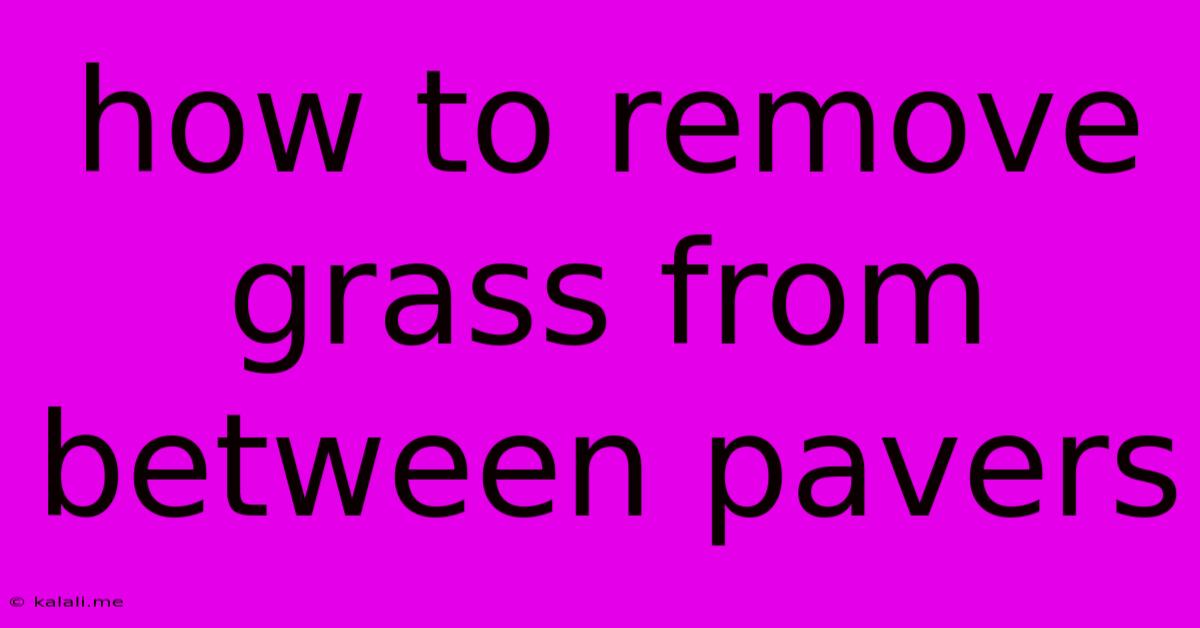How To Remove Grass From Between Pavers
Kalali
May 20, 2025 · 3 min read

Table of Contents
How to Remove Grass From Between Pavers: A Complete Guide
Getting rid of stubborn weeds and grass sprouting between your pavers can feel like a never-ending battle. This comprehensive guide will equip you with the knowledge and techniques to effectively remove unwanted vegetation and maintain the clean, attractive look of your paved areas. We'll cover everything from preventative measures to tackling existing growth, ensuring your pavers remain weed-free for longer.
Understanding the Problem: Why Grass Grows Between Pavers
Grass and weeds find their way between pavers through small gaps and cracks, utilizing the moisture and nutrients trapped in the compacted soil underneath. Seeds are easily carried by wind, water, and even clinging to shoes. The key to effective removal lies in understanding the plant's root system and choosing the right method for your situation.
Methods for Removing Grass Between Pavers
Several effective methods exist for tackling unwanted grass and weeds. Choose the method most appropriate for the severity of the infestation and your personal preference.
1. Manual Removal: This is best for smaller areas or infrequent weed growth.
- Tools: A weeding tool, such as a small hand rake or a narrow trowel, is ideal for gently lifting out grass and weeds.
- Process: Carefully loosen the soil around the base of the plant, then pull the weeds out by their roots. Be gentle to avoid damaging the pavers. This method is time-consuming but effective for preventing weed seeds from spreading.
2. Using a Weed Killer: Chemical methods are quick, especially for larger areas, but require careful application.
- Types: There are various types of herbicides, including selective and non-selective weed killers. Select the appropriate type based on the specific weeds. Non-selective killers will kill all vegetation, while selective killers target specific types of plants.
- Application: Follow the manufacturer's instructions meticulously. This typically involves spraying directly onto the unwanted vegetation, taking care to avoid getting the herbicide on surrounding plants or your skin. Always wear protective gear. Consider using a brush applicator for more precise application and to minimize herbicide drift.
3. Boiling Water: A natural and effective method for small patches.
- Process: Carefully pour boiling water directly onto the unwanted grass and weeds. This kills the plants by burning their roots. Be cautious to avoid scalding yourself or damaging the pavers.
4. Vinegar: A natural alternative to chemical weed killers, though it may require multiple applications.
- Process: Undiluted white vinegar (acetic acid) can effectively kill weeds. Pour it directly onto the unwanted plants. This method is less harsh than boiling water but may require repeated applications for complete removal.
Preventing Future Grass Growth: Proactive Measures
Prevention is always better than cure. Implementing these measures will significantly reduce the chances of future grass and weed growth between your pavers.
- Proper Installation: Ensuring your pavers are properly installed with minimal gaps between them is crucial. Use polymeric sand to fill the gaps effectively, creating a dense barrier against weed growth.
- Regular Maintenance: Regularly sweeping and cleaning your paved area will remove any loose soil or debris where seeds could germinate.
- Weed Barrier Fabric: Laying down a weed barrier fabric before installing the pavers can create a significant obstacle for weed roots.
- Mulching: Applying a layer of mulch can help suppress weed growth by blocking sunlight and creating a less hospitable environment for seeds.
Choosing the Right Method for You
The best method depends on your specific situation. For small areas with occasional weed growth, manual removal might suffice. For larger infestations, a combination of chemical treatment and manual removal could be more effective. Always prioritize safety and follow the instructions of any product you use. Regular maintenance will go a long way in keeping your pavers weed-free and aesthetically pleasing.
Latest Posts
Latest Posts
-
Do Plug Socket Wires Run Up Or Down Uk
May 20, 2025
-
How To Patch A Small Hole In Plaster Ceiling
May 20, 2025
-
How Long Will Fish Live Without A Filter
May 20, 2025
-
Honeywell Thermostat Wiring Diagram 3 Wire
May 20, 2025
-
How To Shut Hot Water Off
May 20, 2025
Related Post
Thank you for visiting our website which covers about How To Remove Grass From Between Pavers . We hope the information provided has been useful to you. Feel free to contact us if you have any questions or need further assistance. See you next time and don't miss to bookmark.